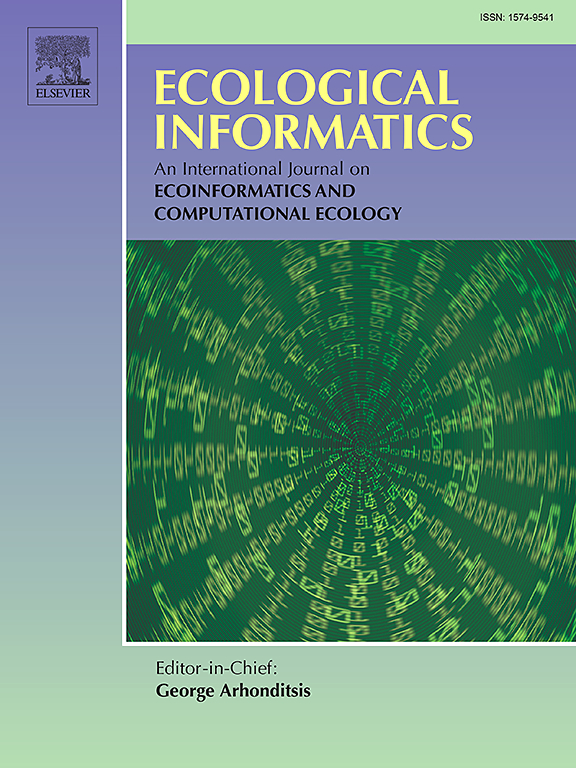印度中西部生态系统对频繁发生的干旱的净固碳量下降:来自卫星测量和模型的推断
IF 7.3
2区 环境科学与生态学
Q1 ECOLOGY
引用次数: 0
摘要
极端天气事件显著影响植被动态,干旱变得越来越频繁,并对植物生长和碳封存产生不利影响。了解植被对此类事件的反应对于有效减缓气候变化至关重要,因为它直接影响生态系统吸收二氧化碳的能力。本研究探讨了2016年印度中西部干旱对植被生产力和生态系统碳交换的影响。我们利用基于卫星的反射产品,包括植被指数(VIs)和太阳诱导叶绿素荧光(SIF),以及来自植被模型的碳通量估计,如新潮集合的一个子集,植被光合作用和呼吸模型(VPRM)和FLUXNET-X。分析了VIs和SIF,以确定植被对干旱的响应,并在缺乏广泛地面观测的情况下评估模型的性能。研究结果表明,由于2016年干旱,该地区的碳吸收能力下降了30 Tg C - 1季。该地区每年仍然是净碳源,其中75%的碳源贡献来自干旱期。然而,生态系统呼吸基本上没有受到影响。干旱显著抑制植被生长,其中落叶植被受影响最为严重。旱后农田恢复较快,灌丛恢复较慢,落叶植被恢复延迟最长。所采用的植被模型产生了不同的生态系统碳通量,但大多数模型对干旱的响应水平相似。这些模式的不确定性强调需要更好地代表该地区的生态过程和高密度观测。这项研究的结果可以帮助在国家层面制定重要的政策决策,特别是在极端天气事件期间管理生态系统和维持碳储存方面。本文章由计算机程序翻译,如有差异,请以英文原文为准。

Declining net carbon sequestration of west-central Indian ecosystem in response to frequently occurring drought: Inference from satellite measurements and modeling
Extreme weather events significantly impact vegetation dynamics, with droughts becoming increasingly frequent and adversely affecting plant growth and carbon sequestration. Understanding vegetation responses to such events is essential for effective climate change mitigation, as it directly influences the capacity of ecosystems to absorb Carbon Dioxide (CO2). This study investigates the impact of the 2016 drought in west-central India on vegetation productivity and ecosystem carbon exchange. We utilize satellite-based reflectance products, including Vegetation Indices (VIs) and Solar-Induced chlorophyll Fluorescence (SIF), alongside carbon flux estimates from vegetation models such as a subset of the TRENDY ensemble, Vegetation Photosynthesis and Respiration Model (VPRM), and FLUXNET-X. VIs and SIF were analyzed to identify the vegetation responses to drought and to assess model performance in the absence of extensive ground-based observations. Our findings indicate that the region’s carbon uptake capacity declined by 30 Tg C season−1 due to the 2016 drought. The region persisted as a net carbon source annually, with 75% of the source contribution from the drought period. However, ecosystem respiration remained largely unaffected. The drought significantly suppressed vegetation growth, with deciduous vegetation experiencing the most severe impact. When croplands recovered more quickly, shrublands showed a slower recovery, and deciduous vegetation exhibited the longest delay in post-drought recovery. The vegetation models employed generated varied ecosystem carbon fluxes, but most of them showed similar levels of responses to the drought. The uncertainties in these models emphasize the need for better representation of ecological processes and high-density observations in this region. The outcome of this study can help in making important policy decisions at the national level, especially for managing ecosystems and maintaining carbon storage during extreme weather events.
求助全文
通过发布文献求助,成功后即可免费获取论文全文。
去求助
来源期刊

Ecological Informatics
环境科学-生态学
CiteScore
8.30
自引率
11.80%
发文量
346
审稿时长
46 days
期刊介绍:
The journal Ecological Informatics is devoted to the publication of high quality, peer-reviewed articles on all aspects of computational ecology, data science and biogeography. The scope of the journal takes into account the data-intensive nature of ecology, the growing capacity of information technology to access, harness and leverage complex data as well as the critical need for informing sustainable management in view of global environmental and climate change.
The nature of the journal is interdisciplinary at the crossover between ecology and informatics. It focuses on novel concepts and techniques for image- and genome-based monitoring and interpretation, sensor- and multimedia-based data acquisition, internet-based data archiving and sharing, data assimilation, modelling and prediction of ecological data.
 求助内容:
求助内容: 应助结果提醒方式:
应助结果提醒方式:


